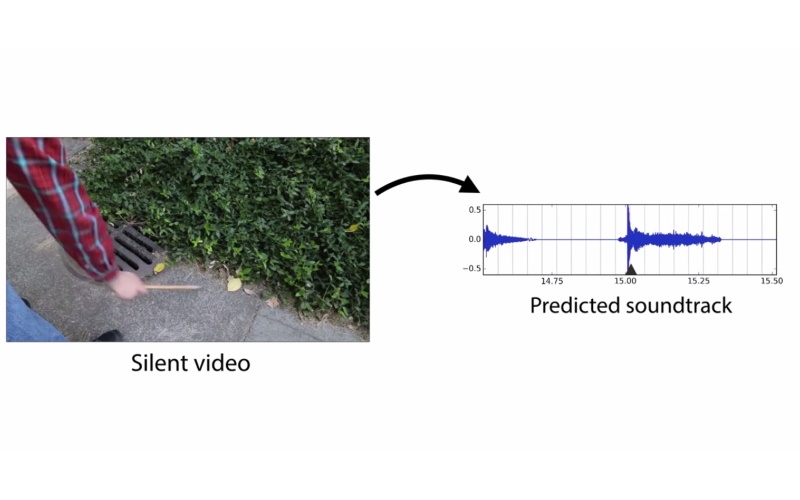- Home
- Science
- Science News
- MIT Develops AI Based System That Adds Sound to Silent Videos
MIT Develops AI-Based System That Adds Sound to Silent Videos

In a series of videos of drumsticks striking things - including sidewalks, grass and metal surfaces - the computer learned to pair a fitting sound effect, such as the sound of a drumstick hitting a piece of wood or rustling leaves.
The findings are an example of the power of deep learning, a type of artificial intelligence whose application is trendy in tech circles. With deep learning, a computer system learns to recognize patterns in huge piles of data and applies what it learns in useful ways.
In this case, the researchers at MIT's Computer Science and Artificial Intelligence Lab recorded about 1,000 videos of a drumstick scraping and hitting real-world objects. These videos were fed to the computer system, which learns what sounds are associated with various actions and surfaces. The sound of the drumstick hitting a piece of wood is different than when it disrupts a pile of leaves.
Once the computer system had all these examples, the researchers gave it silent videos of the same drumstick hitting other surfaces, and they instructed the computer system to pair an appropriate sound with the video.
To do this, the computer selects a pitch and loudness that fits what it sees in the video, and it finds an appropriate sound clip in its database to play with the video.
To demonstrate their accomplishment, the researcher then played half-second video clips for test subjects, who struggled to tell apart whether the clips included an authentic sound or one that a computer system had added artificially.
But the technology is not perfect, as MIT PhD candidate Andrew Owens, the lead author on the research, acknowledged. When the team tried longer video clips, the computer system would sometimes misfire and play a sound when the drumstick was not striking anything. Test subjects immediately knew the audio was not real.
And the researchers were able to get the computer to produce fitting sounds only when they used videos with a drumstick. Creating a computer that automatically provides the best sound effect for any video - the kind of development that could disrupt the sound-effects industry - remains out of reach for now.
Although the technology world has seen significant strides of late in artificial intelligence, there are still big differences in how humans and machines learn. Owens wants to push computer systems to learn more similarly to the way an infant learns about the world: by physically poking and prodding its environment. He sees potential for other researchers to use sound recordings and interactions with materials such as sidewalk cement as a step toward machines' better understanding our physical world.
© 2016 The Washington Post
Catch the latest from the Consumer Electronics Show on Gadgets 360, at our CES 2026 hub.
Related Stories
- Samsung Galaxy Unpacked 2025
- ChatGPT
- Redmi Note 14 Pro+
- iPhone 16
- Apple Vision Pro
- Oneplus 12
- OnePlus Nord CE 3 Lite 5G
- iPhone 13
- Xiaomi 14 Pro
- Oppo Find N3
- Tecno Spark Go (2023)
- Realme V30
- Best Phones Under 25000
- Samsung Galaxy S24 Series
- Cryptocurrency
- iQoo 12
- Samsung Galaxy S24 Ultra
- Giottus
- Samsung Galaxy Z Flip 5
- Apple 'Scary Fast'
- Housefull 5
- GoPro Hero 12 Black Review
- Invincible Season 2
- JioGlass
- HD Ready TV
- Laptop Under 50000
- Smartwatch Under 10000
- Latest Mobile Phones
- Compare Phones
- OPPO Reno 15 Pro Max
- Honor Win RT
- Honor Win
- Xiaomi 17 Ultra Leica Edition
- Xiaomi 17 Ultra
- Huawei Nova 15
- Huawei Nova 15 Pro
- Huawei Nova 15 Ultra
- Asus ProArt P16
- MacBook Pro 14-inch (M5, 2025)
- OPPO Pad Air 5
- Huawei MatePad 11.5 (2026)
- Xiaomi Watch 5
- Huawei Watch 10th Anniversary Edition
- Acerpure Nitro Z Series 100-inch QLED TV
- Samsung 43 Inch LED Ultra HD (4K) Smart TV (UA43UE81AFULXL)
- Asus ROG Ally
- Nintendo Switch Lite
- Haier 1.6 Ton 5 Star Inverter Split AC (HSU19G-MZAID5BN-INV)
- Haier 1.6 Ton 5 Star Inverter Split AC (HSU19G-MZAIM5BN-INV)

















